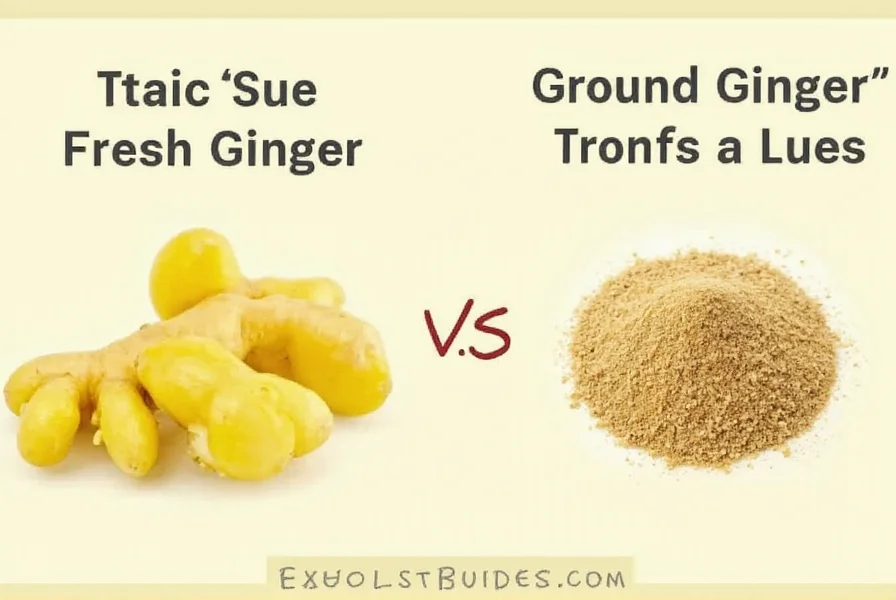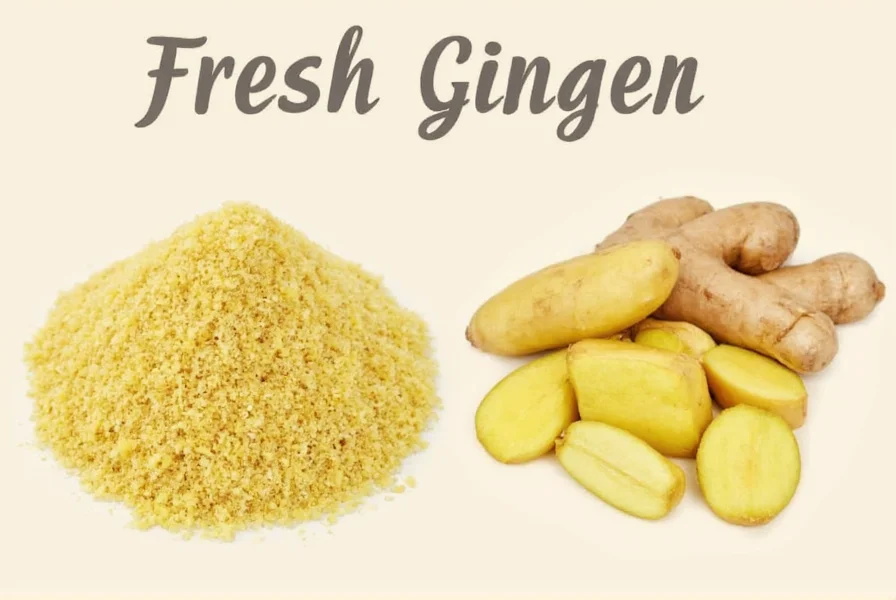Understanding the proper fresh ginger to ground ginger ratio is essential for achieving balanced flavors in your cooking. Many home chefs struggle with substitutions, often resulting in dishes that are either too mild or overwhelmingly spicy. The key factor is moisture content: fresh ginger contains about 80% water, while ground ginger has been dehydrated, concentrating its flavor compounds.
Why the 4:1 Conversion Ratio Works
When ginger is dried and ground, it loses approximately 80% of its weight through moisture evaporation. This concentration effect means you need significantly less ground ginger to achieve similar flavor intensity. The 4:1 ratio (fresh to ground) has been validated through culinary testing across various cooking applications, from baking to savory dishes.
| Fresh Ginger | Ground Ginger Equivalent | Best For |
|---|---|---|
| 1 inch knob (about 1 tbsp grated) | ¼ tsp | Stir-fries, marinades |
| 1 tbsp grated | ¼ tsp | Sauces, dressings |
| 1¼ inch knob | ½ tsp | Baking, spice blends |
| 1½ inch knob | ¾ tsp | Curries, hearty stews |
| 2 inch knob | 1 tsp | Strongly flavored dishes |
Flavor Profile Differences You Should Know
While the 4:1 ratio provides a good starting point, understanding flavor differences prevents recipe failures. Fresh ginger offers bright, citrusy notes with a sharper heat that dissipates quickly. Ground ginger delivers warmer, earthier flavors with a more persistent warmth. In delicate dishes like seafood or light sauces, the flavor difference becomes particularly noticeable.
For baking applications like gingerbread or spice cakes, you can often use a slightly more generous substitution (up to 5:1 ratio) because ground ginger's warmer notes complement sweet applications. In savory Asian cuisine, however, sticking strictly to the 4:1 ratio preserves authentic flavor profiles.

When Substitutions Work Best
Not all recipes tolerate ginger substitutions equally. Understanding which dishes accommodate substitutions prevents culinary disasters:
- Good candidates: Baked goods, spice rubs, chai tea, and hearty stews where precise ginger flavor isn't critical
- Poor candidates: Sushi ginger, ceviche, fresh salsas, and delicate seafood dishes where fresh ginger's bright notes are essential
- Adjustment tip: When substituting in sensitive recipes, add ground ginger gradually, tasting after each addition
Storage Considerations Affecting Your Ratio
Fresh ginger's age impacts its potency. Older ginger (more than 2 weeks refrigerated) loses moisture and becomes slightly more concentrated. For ginger approaching spoilage, you might adjust to a 3.5:1 ratio. Conversely, newly harvested ginger with high moisture content may require a 4.5:1 ratio.
Ground ginger also degrades over time. Properly stored in an airtight container away from light, it maintains potency for 2-3 years. Older ground ginger may require slightly increased amounts—about 10-15% more—to achieve equivalent flavor.

Common Substitution Mistakes to Avoid
Many home cooks make critical errors when substituting ginger forms:
- Assuming equal volume: Using 1:1 measurements creates overwhelmingly spicy dishes
- Ignoring recipe timing: Adding ground ginger too early in cooking diminishes its flavor
- Not adjusting for other spices: When substituting, consider reducing complementary spices like cinnamon or cloves by 10-15%
- Using old ground ginger: Stale spices require larger quantities, throwing off flavor balance
For best results in critical recipes, consider making your own ground ginger from fresh. Simply peel, dehydrate, and grind your ginger for maximum flavor control. This homemade version typically follows the standard 4:1 ratio more precisely than commercial products, which vary in processing methods.
Practical Application in Popular Recipes
Understanding fresh ginger to ground ginger conversion ratios transforms your cooking:
- Stir-fries: Use 1 tbsp fresh ginger (or ¼ tsp ground) per pound of protein for balanced heat
- Ginger tea: 1-inch fresh ginger knob equals ½ tsp ground ginger in hot water
- Curry pastes: For every 2 tbsp fresh ginger, substitute ½ tsp ground ginger plus ¼ tsp lemon zest to mimic fresh brightness
- Ginger cookies: 1¼ inch fresh ginger knob equals ½ tsp ground ginger plus ¼ tsp molasses for depth
Final Conversion Tips for Perfect Results
Mastering the fresh ginger to ground ginger ratio requires attention to detail. Always start with less ground ginger than you think you need—you can always add more, but you can't remove excess. For critical dishes, conduct a small test batch first. Remember that personal taste preferences vary, so adjust the ratio to suit your palate while maintaining the recipe's structural integrity.
Frequently Asked Questions
Can I substitute ground ginger for fresh in sushi ginger?
No, ground ginger doesn't work well for sushi ginger preparation. The fresh form's texture and bright acidity are essential for proper pickling. Ground ginger would create a muddy texture and overpowering heat that ruins the delicate balance required for sushi accompaniments.
Does the fresh ginger to ground ginger ratio change for baking versus cooking?
Yes, the ratio varies slightly by application. For baking, you can often use a 5:1 ratio (more ground ginger) because its warmer notes complement sweet dishes. For savory cooking, especially Asian cuisine, maintain the standard 4:1 ratio to preserve authentic flavor profiles. In delicate sauces, consider a 4.5:1 ratio for subtler results.
How do I adjust recipes when using old ground ginger?
For ground ginger older than 18 months, increase the amount by 10-15% beyond the standard conversion. Test by mixing a small portion of your spice blend with liquid before adding to the entire recipe. If the ginger flavor seems weak after 5 minutes of cooking, add an additional 1/16 teaspoon increments until desired intensity is achieved.
Why does my dish taste different even when I follow the fresh ginger to ground ginger ratio correctly?
The flavor difference stems from chemical composition changes during drying. Fresh ginger contains zingerone and shogaols that provide bright, sharp heat, while ground ginger's gingerols transform into zingerone during processing, creating warmer, earthier notes. To bridge this gap, add a pinch of lemon zest or 1/8 teaspoon vinegar when substituting ground for fresh in savory dishes.
Can I make my own ground ginger from fresh, and what ratio should I use?
Yes, making your own ground ginger ensures maximum freshness. Peel, thinly slice, and dehydrate fresh ginger at 135°F for 8-10 hours until brittle. Grind to powder and store airtight. Homemade ground ginger follows the standard 4:1 ratio more precisely than commercial products, which often use older ginger or different processing methods that affect potency.











 浙公网安备
33010002000092号
浙公网安备
33010002000092号 浙B2-20120091-4
浙B2-20120091-4